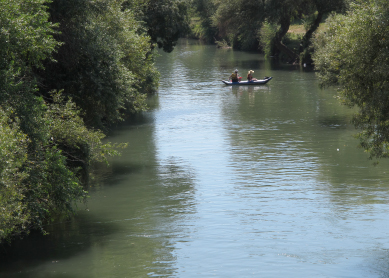The course of the Jordan River begins in the northeast corner of the Hulah Valley of Israel, running south to the Sea of Galilee (also called the Kinneret) and then on to the Dead Sea near Jericho. The river is approximately 250 kilometers long. Throughout history, the Jordan has been an essential natural feature in a land marked by political and religious conflict. In modern times, the river serves as both a geopolitical boundary and a source of religious fascination, especially for Christians.
Was the Jordan River an important geopolitical border in biblical times?
Throughout the Hebrew Bible, the Jordan River serves primarily as a regional indicator and a boundary, both real and symbolic. Early in the biblical narrative, Lot discovers that the “plain of the Jordan was well watered everywhere like the garden of the Lord” (Gen 13:10) and decides to settle there. The book of Numbers discusses the distribution of populations, including Canaanites who “live by the sea and along the Jordan” (Num 13:29). Later, after Moses leads them out of the wilderness, the Israelites are so successful in conquering land east of the Jordan that the Reubenites, Gadites, and half the tribe of Manasseh prefer to stay on the east side of the Jordan and establish their tribal territories there (Num 32). Moses is allowed to gaze across the Jordan River at the promised land, but he is not allowed to cross the river (Deut 3). This idea of crossing over the Jordan later becomes a metaphor for liberation, mentioned explicitly in African American spirituals such as “Michael Row Your Boat Ashore.”
Crossing the Jordan becomes a pivotal motif in Israelite self-understanding (Deut 31:13). After the death of Moses, the majority of the tribes cross over the Jordan under Joshua, with the priests holding the ark of the covenant midstream to stop the flow of the river (Josh 3). This miraculous crossing is remembered symbolically (Josh 4) and is said to strike fear in the hearts of the kings west of the Jordan, to the point that “their hearts melted, and there was no longer any spirit in them, because of the Israelites” (Josh 5:1).
In the rest of the book of Joshua and in Judges, the Jordan frequently serves as a geographical marker—in stories of conquest (Josh 12), distribution of the territories (Josh 13-20), and conflict between the Israelite tribes (Josh 22). According to the text of Judges, the fords of the Jordan become famous as the place where 42,000 Ephraimites (probably an exaggerated number) are slain by the Gileadites when they are unable to pronounce the famous password “Shibboleth” (Judg 12:6).
Under the monarchy, the Jordan continues to be a significant border and a place where God demonstrates his power. In 2Sam 19, David crosses the Jordan and returns to his kingdom after the death of his son Absalom. In 2Kgs 2, Elijah strikes the Jordan with his cloak and causes the water to back up so that he and Elisha can cross over on dry land. After Elijah is taken up to heaven in a whirlwind (2Kgs 2:11), Elisha assumes the authority of Elijah and uses his cloak to again stop the river and cross on dry land.
Is the modern Christian fascination with baptism in the Jordan River justified?
In the New Testament, the Jordan River continues to serve as a territorial marker (Matt 4:25, Matt 19:1, Mark 10:1). However it is featured mainly as the site where baptisms take place, conducted first by John (Matt 3, Mark 1, Luke 3, John 1) and then by Jesus and his disciples (John 3:26). This last reference suggests that some kind of competition developed between the ministry of baptism by Jesus and that of John (John 4:1-2). Interestingly, the account of Jesus’ own baptism in Luke’s gospel does not mention John, who is put into prison right before it occurs (Luke 3:20-21). Although John’s gospel mentions John, and uses language reminiscent of Jesus’ baptism in the synoptic Gospels, it never explicitly says that Jesus was baptized (John 1:29-34).
After the initial flurry of baptismal activity at the Jordan, action in the Gospels shifts to other regions (the Galilee and Jerusalem) and activities (preaching, miracles, suffering). Baptism returns as a significant theme in the book of Acts and the Letters. Although baptism continues to be a significant rite of passage into the community of Jesus’ followers, it is also connected to controversy—over believers’ allegiance to the person who baptized them and to “baptism by the Holy Spirit” (1Cor 1:13-17, Acts 19:1-7). This later discussion of baptism is entirely removed from the Jordan River.
The modern Christian fascination with the Jordan River as a place of baptism is apparent, especially at certain baptismal sites near the Sea of Galilee and, more recently, east of Jericho. Though this practice captures the spirit of one important period of activity within the earliest Palestinian Jesus movement, the biblical traditions associated with the Jordan go far beyond this particular ritual.
Bibliography
- Glueck, Nelson. “The Jordan.” Biblical Archaeologist 6 (1943): 61–67. Har-El, Menashe. “The Pride of the Jordan: The Jungle of the Jordan.” Biblical Archaeologist 41 (1978): 64–75.
- Har-El, Menashe. “The Pride of the Jordan: The Jungle of the Jordan.” Biblical Archaeologist 41 (1978): 64–75.
- Havrelock, Rachel. River Jordan: The Mythology of a Dividing Line. Chicago: University of Chicago Press, 2011.
- Van der Steen, E. J. Tribes and Territories in Transition: The Central East Jordan Valley in the Late Bronze and Early Iron Ages; A Study of the Sources. Leuven: Peeters, 2004.
- Mithen, Steven, ed. Water, Life and Civilisation: Climate, Environment and Society in the Jordan Valley. Cambridge: Cambridge University Press, 2011.



